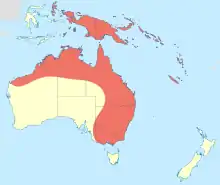Isostictidae
Isostictidae is a small family of medium-sized to large damselflies restricted to Australia, New Caledonia, and New Guinea.[2] It contains 12 genera and more than 40 species. Members of this family resemble species in the threadtail family (Protoneuridae).
| Isostictidae | |
|---|---|
 | |
| Oristicta filicicola | |
| Scientific classification | |
| Domain: | Eukaryota |
| Kingdom: | Animalia |
| Phylum: | Arthropoda |
| Class: | Insecta |
| Order: | Odonata |
| Suborder: | Zygoptera |
| Family: | Isostictidae Fraser, 1955[1] |
| Genera | |
|
Austrosticta | |
 | |
Diagnosis
- Adult: The adults are small to medium in size with a length of 15–40 mm. They have two antenodal crossveins, most postnodal crossveins aligned with crossveins behind them, quadrilateral cell almost rectangular, no supplementary intercalary longitudinal veins, and an anal vein fused with wing margin. Their antennae are seven-segmented.
- Larva: The larva has a labial mask short, flat, palps narrow, palpal setae present, premental setae variable, median lobe shallowly cleft; caudal gills saccular to triquetral, strongly nodate.
Ecology
Adults of Isostictidae have many common names and they are narrow-wings, pinflies, pins, pondsitters, and wiretails.
- Instream habitat: Isostictid damselfly nymphs occur in streams, rivers, and riverine pools. The adults occur along these habitats. The nymphs are found on submerged vegetation, willow roots, leaf packs and detritus.
- Feeding ecology: Nymphs and adults are predators.
- Habits: Nymphs of these damselflies are clingers. Adults like to rest on many different plants.
- Life history: Some females of some species lay their eggs in dry twigs over lentic freshwater. Other female species may lay their eggs on the bare rocks of waterfalls.
See also
Wikimedia Commons has media related to Isostictidae.
Wikispecies has information related to Isostictidae.
References
- Dijkstra, K.D.B.; et al. (2013). "The classification and diversity of dragonflies and damselflies (Odonata). In: Zhang, Z.-Q. (Ed.) Animal Biodiversity: An Outline of Higher-level Classification and Survey of Taxonomic Richness (Addenda 2013)". Zootaxa. 3703 (1): 36–45. doi:10.11646/zootaxa.3703.1.9. hdl:10072/61365. Archived from the original on 2018-08-14. Retrieved 2017-03-30.
- "Family ISOSTICTIDAE". Australian Faunal Directory. Australian Biological Resources Study. 2014. Retrieved 30 March 2017.
This article is issued from Wikipedia. The text is licensed under Creative Commons - Attribution - Sharealike. Additional terms may apply for the media files.